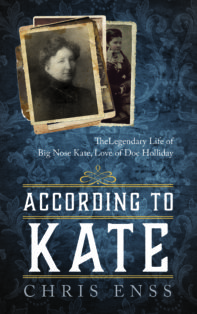Enter now to win a copy of the book
According to Kate:
The Legendary Life of Big Nose Kate Elder, Doc Holliday’s Love
and a Kindle Paperwhite.
The main street of Las Vegas, New Mexico, was so crowded the passing streams of people moved as if unseen hands were dragging them this way and that. In addition to the throngs of people crossing back and forth across the dusty thoroughfare, there were teams of horses pulling buckboards and business buggies, cowhands leading their mounts to the livery, and ranchers hauling supplies in and out of town. Kate and Doc added to the chaos when they arrived just before Christmas 1878. After tending to their rides and securing a room at the Adobe Hotel in Gallinas Canyon north of the central plaza of town, Kate put Doc to bed. He was coughing a wet cough that produced enough blood to saturate a handkerchief. Doc wasn’t the only tuberculosis sufferer in Las Vegas. Many patients had gathered in the New Mexico location. Dry air and rest were the only remedies for the disease. Sometimes bundled in blankets and sheltered from precipitation, patients there endured outdoor life in all weather, hoping the regimen would heal their damaged lungs.
Tuberculosis patients also sought to rid themselves of the disease by soaking in the hot springs six miles northwest of town. The September 30, 1878, edition of the Daily Gazette noted that the hot springs near Las Vegas contained the same mineral constituents as those in Hot Springs, Arkansas, and Thermal Springs in Europe. Frontier physicians recommended soaking in the calcium and sodium enriched hot springs because the bicarbonates boosted blood circulation, reduced pain, and repaired tissue damage. According to Kate, she tried to convince Doc to consider staying put until his health was somewhat restored. She hoped he would take advantage of the hot springs and the rest. The attack he had in Dodge City had left him weak and unsteady on his feet. Kate promised to provide for them both while he was recovering, but Doc refused to go along with her plan.
As soon as Doc was able, he located office space on Bridge Street and opened his practice. Las Vegas was a stopping point for those traveling along the Santa Fe Trail, it was the biggest city between San Francisco and Independence, Missouri. Doc anticipated there would be many people in need of a dentist. The army post, Fort Union, was twenty miles north of Las Vegas, and soldiers routinely spent time in town enjoying the nightlife. If Doc’s practice faltered for any reason, he could also sustain himself at the poker table. Las Vegas continually played host to cavalrymen, desperados, and outlaws looking for a fast game. The number of card players eager to be separated from their money swelled when the Atchison, Topeka, and Santa Fe Railroad reached the area. Before Doc had an opportunity to fully fleece amateur card sharps, the New Mexico territorial legislature passed a bill prohibiting gambling. The law didn’t stop Doc from dealing, however; he kept his games of chance quiet while maintaining the semblance of an upstanding citizen as the community’s respectable dentist.

To learn more about Kate read
According to Kate: The Legendary Life of Big Nose Kate Elder,
Doc Holliday’s Love



